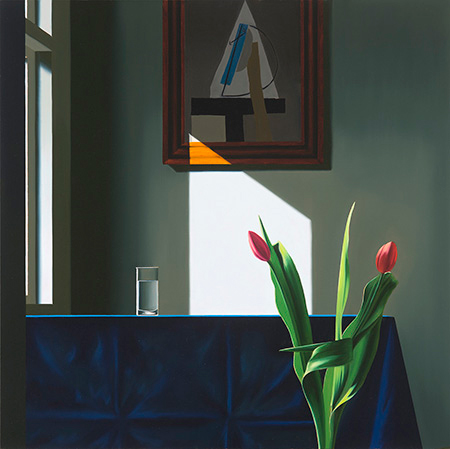
Continuing through April 2, 2016
Although art designated as Realism is rife with art historical precedents, Contemporary Realism emerged during the late 1960's and early 70’s, a reaction, at that time to the popularity of abstraction and hard-edge paintings. The movement drew the interests of artists such as California based Bruce Cohen. Differentiated from the American Social Realism movement of the 1930s, this was a tendency characterized by the distinctive blending of realism with surrealism. Cohen’s paintings maintain hard-edge techniques that are characteristically fundamental to his vision.
Drawn to realistic techniques and unusual perspectives, Cohen is particularly inspired by the sense of order found in 17th-century Dutch still life paintings. At the same time, the other-worldliness of Surrealism also plays a pivotal role. However, it is the density of detail and decorative ambiguities in Indian miniature paintings that most impact his visions.
Cohen’s surrealist instincts come into play in his ability to express psychological states through interior spaces. Artists have long been interested in depicting interiors, and indeed, his paintings recall the unusual interior juxtapositions and vantage points of Matisse and Magritte. Unlike such antecedents, Cohen’s works transcend rationality through the use of hyper-real representation. Though they entail layers of decision-making in the arrangement of objects and architectural elements, Cohen adds unusual angles and points of view to soften any feeling of rigidity or premeditation.
Though he uses a combination of saturated and muted hues, he is particularly masterful in generating light sources that draw inspiration from Vermeer. But by translating light and shadows into grid-like patterns, he manages to evoke distinctively magical auras. It is evident in paintings such as “Interior View of Garden,” where the geometry of the doorway is reflected in the light beams on the floor.
By the same token, Cohen evokes modern versions of 17th-century chiaroscuro techniques by placing equal weight on shadows. A prime example is “Interior with Glass of Water and Picasso Collage.” Here, in sharp contrast to dark shadows, a single shaft of light takes on special value.
Freshly cut fruit and floral arrangements also provide important clues to the sensibilities of the occupants. In “Still Life with Papaya,” for instance, fruit that is cut in half offers evidence of absent inhabitants. Colorful flowers, displayed in a variety of artistic vases, are further evidence. Though Western art historical references to flowers carry a plethora of symbolism, in Cohen’s interiors, they add an aesthetic quality to the eerie isolation of the rooms. In “Iris and Lemons on Glass Table” for example, a glass vase of flowers sits on a reflective surface. It is as sensuous a vision as a nude figure.
Drawing from objects both observed and invented, pristinely ordered spaces serve as tools to create moody atmospheres. But they are so resolutely structured, arranged seemingly by someone with obsessive- compulsive disorder. At the same time, they tap into Surrealist emphasis on the power of imagination. There is an eerie absence of human figures and suggestions of mystery glimpsed through open doors and windows. As in “Kitchen Interior with Seascape,” views of ocean and sky hint at worlds beyond the isolation of the interior.
Though they are imaginative spaces, the pristine beauty of these paintings overrides the intrigue. In fact, his allegorical visions hint at modern versions of Renaissance genre paintings. Like his ancestors, the impetus is to create interiors to meditate on.
Published Courtesy of ArtSceneCal ©2016
